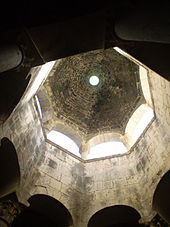Arab baths (Girona)
Coordinates: 41 ° 59 ′ 17.5 " N , 2 ° 49 ′ 32.7" E
The Arab Baths (Catalan Banys àrabs , Spanish Baños árabes ) in Girona , a Spanish city in northeastern Catalonia , were built in the late 12th century. In 1931 the bathing complex on Passeig Arqueològic was declared a monument ( Bien de Interés Cultural ).
Building description
This Romanesque bathing complex was built in 1294 in place of a corresponding previous building from the late 12th century for the Christian residents of the city of Girona. It consists of four functional rooms.
The introductory changing room, the apodyterium, is the most characteristic room in the entire bathing complex. In the middle of this room is a small octagonal water basin, which is surrounded by tall columns with beautiful capitals. The pillars carry a volcanic stone lantern , a dome with openwork windows. The capitals show natural and animal themes, specifically allegories of the Garden of Eden and animal figures of Christian symbolism.
In the following frigidarium , the cold room, the first application was cool foot baths or cold water showers. This frigidarium was entered through double swing doors, so that the room was watertight and thus also remained cool.
In the following tepidarium , the warm room, the bathers were able to warm up from the intensive cold treatment and prepare for the upcoming heat bath.
In the final caldarium , bath users can enjoy a steam bath. The heat was generated in an underground furnace called the hypocaust . It was led into the caldarium via a channel built into the wall, a wall shaft and underfloor heating. This heat source also heated the water in a kettle ( caldera ) and converted it into steam. The temperature in the caldarium could exceed 50 degrees Celsius. The disadvantage of the process was probably a strong development of smoke, which should also have been noticeable in the kaldarium.
history
The first construction of a bath complex at this point probably dates back to the 12th century. The exact origin of the bath complex is not known. The complex was first mentioned in 1194. King Alfonso II (Alfonso the Chaste) donates part of his income from the bathing establishment to an institution associated with the neighboring Girona Cathedral. In 1285 this first bath complex was destroyed during the French invasion under King Philip the Bold . King James II of Aragon commissioned the judge at the royal court of Girona Ramon de Taialà to rebuild the baths in 1294 . In 1342 Arnau Sarriera , the personal physician of Peter IV. Von Aragon , became the owner of the property. In 1416, Pere Terrades sold half of the bath complex with the adjacent buildings to the rector of the charitable institution Pia Almoina de Girona . It seems that the bathing business was stopped at the end of the 14th century when the complex became privately owned. In 1618 the property was taken over by the Capuchins of the Anunciació Monastery . They converted it into a closed convent. The actual bathroom facility was used as a kitchen and wash house during this period . In 1929 the Diputació de Girona (the administrative district of Girona) took over the complex, which was then thoroughly restored from 1930 to 1931 by the architects Rafael Masó, Jeroni Martorell and Emili Blanch and opened to the public in 1932.
classification
The Arab baths are a replica of North African baths, as you can find them in many places in the Mediterranean. They take up an Arab tradition, which gave the baths the popular name Arab baths in the 19th century . During the Middle Ages, these baths were mainly used by Christians from Girona, even though a separate room for ritual baths was set up in the complex for Girones Jews in the 13th and 14th centuries.
literature
- Jaime Cobreros: Las Rutas del Románico en España . Volume 2. Madrid 2004, ISBN 84-9776-112-X , pp. 46-47 .
- Consell Comarcal del Gironès, Àrea de Cultura and Oficina comarcal de Turisme del Gironès (Editor): Els Banys Àrabs . Detailed leaflet on the Arab Baths in Girona in Catalan, Spanish, French and English. 2016.
Web links
- Generalitat de Catalunya: Banys àrabs. Retrieved March 27, 2018 (Catalan).
- City of Girona: Banys àrabs. Retrieved March 27, 2018 (Catalan).
Individual evidence
- ↑ The chapters Building Description, History and Classification were significantly expanded on March 27, 2018 and some were written for the first time after the detailed leaflet: Consell Comarcal del Gironès, Àrea de Cultura and Oficina comarcal de Turisme del Gironès (publisher): Els Banys Àrabs.





